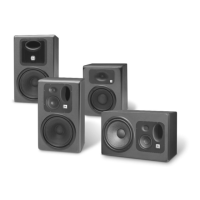21
While there are only HOT and GROUND/SHIELD connections from unbalanced sources, it is recommended
that high quality twisted pair cable be used. Figure B shows an unbalanced source connected to the balanced XLR
input of the LSR monitor using twisted pair cable. Note that the shield is connected to the GROUND/SHIELD connec-
tor at the LSR input, but not at the source. This reduces the likelihood of introducing a ground loop into the system.
Unbalanced Diagram B
When using unbalanced signals with an LSR28P, it is recommended to use a 1/4” Tip/Ring/Sleeve connec-
tor. This input has been specifically designed to accommodate a wide variety of balanced and unbalanced connec-
tions. Figure C shows when using the 1/4” Tip/Ring/Sleeve connection, the GROUND should be tied to the source and
not the sleeve of the LSR input for optimum performance.
Unbalanced Diagram C
Figure D details the connections using single conductor shielded cable with a Tip/Ring/Sleeve plug for the
LSR28P input. Single conductor cable should be used as a last resort as it provides the most possibility for problems.
The “HOT” (+) signal should be connected to the tip of the Tip/Ring/Sleeve plug. The GROUND should be attached
to the Ring of the Tip/Ring/Sleeve plug at the LSR28P input.
Unbalanced Diagram D

